Case Studies
Ten case studies were constructed to explore the pedagogical benefits of 3DVLEs and identify challenges in teaching in 3DVLEs across different disciplinary fields. The complete case studies are available for download from the project site. The following sections provide abstracts of each case study and links to the download sites.
Case Studies
- Accessible Interactive Media
- Client Services in Libraries and Information Resources and Services
- Digital Interactive Multimedia
- Electronic Arts: Visual Theatre
- Electronic Publishing on the Internet
- From Mickey to Manga
- Health Science Mammography, Lactation Clinic and Chiropractic Simulations
- Higher Degree (MEd and PhD) Research Students (HDR) Workshops
- Information Literacy
- Virtual Literacy Ethnography in Second Life
Accessible Interactive Media
University of South Australia
The Accessible Interactive Media course introduces students to the principles of usability and accessibility in Web design, and gives students the chance to create websites for 'real clients'. In this case study, students undertook their projects with health and disability related groups located in Second Life. The virtual world was used as a conduit enabling students to liaise with their clients and attend debriefing meetings with the course coordinator, and members of the disability support groups.
The key learning outcomes for the students were to:- demonstrate an understanding of the needs of users with disabilities and the importance of web accessibility;
- demonstrate understanding of the W3C Web Content Accessibility Guidelines, website analysis and the use of accessibility auditing tools;
- design and develop an accessible website for their allocated client.
Download the Accessible Interactive Media case study.(PDF Format)
Back to top
Client Services in Libraries and Information Science
Edith Cowan University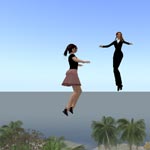
This case study explored the use of Second Life as a medium for Library and Information Services students to practice conducting effective reference interviews. Students role played client/librarian relationships in the virtual world and were given the opportunity to share their views about the experience.
Download the Client Services in Libraries and Information Science case study.(PDF Format)
Back to top
Digital Interactive Multimedia
University of South Australia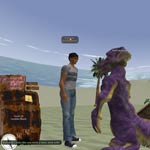
This course saw the use of Second Life to allow students to create and customise their own interactive game, inside the virtual environment.
The key learning outcomes for students were:- work collaboratively and communicate effectively with team members;
- solve complex problems in a complex gaming environment;
- design and develop an interactive game in a 3D virtual world;
- engage in reflective practice through peer review.
Download the Digital Interactive Multimedia case study.(PDF Format)
Back to top
Electronic Arts:Visual Theatre
University of South Australia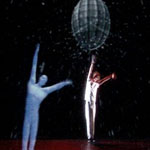
This course made use of Second Life as a medium for experimental theatre, combining real actors live onstage with virtual counterparts, that were being controlled 'live' through the Second Life environment, projected on stage.
Students completing the course were required to demonstrate their understanding and mastery of visual theatre concepts based on the following criteria:- Integration of the live performer with the projected image;
- Live body extension, posture and balance;
- Live and virtual bodies, voices and characters;
- Rhythm of live and projected action;
- Relating to the audience;
- Geography of Second Life.
Download the Electronic Arts: Visual Theatre case study.(PDF Format)
Back to top
Electronic Publishing on the Internet
University of South Australia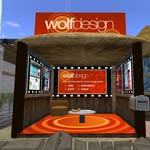
This course combined activities in Second Life with traditional web design activities undertaken in class to provide a means by which students could build their professional portfolios with a consistent presence across both the web and 3D environments.
The key learning outcomes for the students were to:- design and develop a portfolio presence in a 3D virtual world ;
- design and develop a complementary Website linked to their 3D world ‘shop front’ portfolio in Second Life;
- create an online feedback form enabling students to critique each other’s portfolios and engage in reflective practice.
Download the Electronic Publishing on the Internet case study.(PDF Format)
Back to top
From Mickey to Manga: Understanding The Animated Image
University of South Australia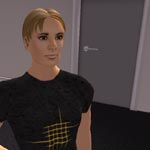
The course, From Mickey to Manga provided students with the opportunity to theorise and critique newer forms of media and apply their knowledge through three dimensional screen animation and immersive games. The use of Second Life allowed students to interact learn, study, work and interact off campus and from remote locations, while also immersing themselves in the course material by becoming avatars themselves.
Download the case study.(PDF Format)
Back to top
Health Science Mammography, Lactation Clinic and Chiropractic Simulations
Royal Melbourne Institute of Technology / University of South Australia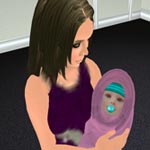
This project investigated the engagement, student experience and flexibility of using a 3DVLE to simulate the patient history taking process in health science related fields. Students practiced effective communication skills and strategies by role playing scenarios involving interactions with patients to determine important information essential to their treatment.
Download the case study.(PDF Format)
Back to top
Higher Degree (MEd and PhD) Research Students (HDR) Workshops
Monash University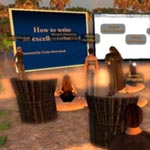
The aim of this case study was to explore the implications for students and lecturers of using a 3DVLE in delivering Higher Degree Research Student (HDR) workshops. Students participated in several online workshops, dealing with subjects such as abstract writing and research ethics, and they were invited to evaluate the effectiveness of Second Life as a platform for delivery of learning activities for HDR Students.
Download the HDR Workshops case study.(PDF Format)
Back to top
Information Literacy (core Level 1 module in the programme BSc Information Management)
University of Sheffield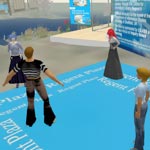
This course, which is designed to progress students' information literacy and develop their understanding of information literacy theories and practice, utilised Second Life as part of a blended learning approach, enabling students to perform online interviews, undertake research projects and create presentations to display in an online environment.
Download the Information Literacy case study.(PDF Format)
Back to top
Virtual Literacy Ethnography in Second Life
University of Sheffield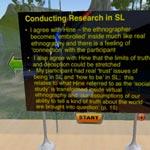
This course considered how new technologies are affecting the way literacy and language conventions are changing and at the ways in which we are using literacy and language differently in a digital age, focusing on Second Life.
The aims of the unit were to introduce students to the concept of virtual ethnography and to enable them to conduct an ethnography of literacy practices in Second Life.
Objectives:- To develop students' understanding of the nature of ethnography in virtual worlds;
- To enable students to undertake an ethnographic study of literacy in an area of Second Life (i.e. a specific location, or with a group of specific participants);
- To familiarise students with literacy practices undertaken in Second Life and enable them to reflect on these in the light of previous work on the nature of literacy in a digital age.
Download the Ethnography in Second Life case study.(PDF Format)

